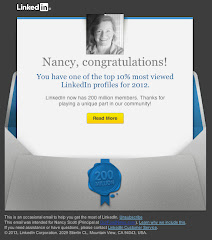 |
| ©CCRockyRaccoonakaSeedThiefcourtesyofJerryMcFarland |
We’re ALL guilty !
Consider the sort of “extravagances” the average American pours money into without thinking. But why? We can do it
much cheaper by doing it ourselves, reusing/recycling, consuming less, cutting back, getting simple, and holding-on longer.
Curiously, we expend so much energy and so many resources on services and "luxuries" that we have no
time left to do things cheaply! The best example I can think of is gym memberships v. … walking … or … biking … or running … or gardening … or mowing the lawn!
It’s as though we're too busy to do
anything for ourselves. How did this happen?
1. Beauty
• Hair. We depend on others to cut it, color it, trim it, condition it. At least we grow it ourselves?
• Nails. Somebody else cuts our toenails. Yikes!
• Skincare. Machines and medicines, dermatologists and surgeons. And it
still wrinkles.
• Weightloss. How many diets, how many drugs does it take to lose how many pounds?
2. Pets
• Food. What happened to table scraps?
• Vets. Accpuncture? Oh my, please don't get me started.
• Grooming. Seriously?
• Training. Just watch "The Dog Whisperer." Cesar is all you need to know.
• Insurance. In case your dog bites [or kills] somebody [see Training above].
3. Clothes
• Chasing Fashion. Fashion changes faster than your weight. Who can keep up?
4. Technology
• Designer cellphones. If you need to make a call, you don't need fingerprint access.
• Computer choices. You can get it cheaper. You know you can.
• Entertainment. Pokeman go? But why? Why?
Why?
5. Housing
• Size. How many siblings slept in your mom or dad's bedroom?
• Location. We pay a lot for "neighborhood." And then we never meet our neighbors.
• Furnishings. You can never have too many pillows or mattresses or patio chairs or ...
• Professional landscaping. Hmmmm....
6. Vacations
• Hotels. Airbnb.
• Destination vacations. Try Disney v. Yellowstone. Six Flags v. Appalachian Trail ..
7. Automobiles
• Expensive Make. Because .... ?
• Latest Model. Because .... ?
8. Children’s Activities
• Special classes. For the super talented, maybe ...
• Sports gear. For the special classes, always ...
• Toys et al. For the uninspired and the unnecessary...
9. Medical Services
• Medication reliance. Doc on speed dial.
• Designer drugs. Versus generics.
10. Religion/Spirituality
• Special classes. Necessary? You decide.
• Retreats.
Necessary or fun? You decide.
11. Entertainment/Leisure Time
• Bars. Cheaper at home.
• Restaurants. Cheaper at home.
• Gyms and Spas. Cheaper at home.
• Yoga classes. Cheaper at home.
12. Food
• Dining out. More fun at home, at least part of the time.
• Buying full- or partially-prepared items. Parboiling costs a lot, prechopped blows the budget.
Clearly, without the service economy in America, a lot of us would be unemployed. But do we really want to pay somebody else to do everything
for us?
Yes? No? Let's talk about it ...
-- scrubbed by MarketingBrillo








